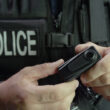Physical security continues to be an issue at radio sites
This article is the second in a series regarding best practices for Project 25 (P25) systems that were unveiled during a workshop in Washington, D.C., sponsored by Tait Communications.
At a time when significant amounts of national and international focus are being placed on privacy issues and the hacking of networks that house sensitive information, P25 operators currently have greater concerns about the physical security of their network equipment and systems.
“We are less worried about somebody trying to hack into our system on a computer than we are somebody running into one of these equipment buildings and putting an ax to it,” said Larry Britton, radio systems specialist for Charleston County, S.C.
Fencing around tower sites and separate shelters for public-safety communications equipment was advocated by most, but it is not always an option. In New Hampshire, fencing on some mountaintop sites is prohibited, and all users of such sites have to share a single shelter, although public-safety gear can be partitioned from commercial equipment through the use of chicken-wire fencing inside the shelter, according to Paul Leary, chief of communications for the state of New Hampshire.
With budgets tight, site sharing is going to become more common, so system operators should consider carefully how they want to secure their systems’ equipment in an environment where others will be present, said David Schwartz, deputy chief of the public-safety communications division of the city of Indianapolis.
“We want to keep a closed network now, but we’re going to have to think more outside the box in the coming years,” Schwartz said.
Craig Jorgensen, former president of the P25 steering committee, echoed this sentiment.
“Economically, public safety is going to have to recognize that, in the long term, we’re going to have to have more consolidated projects with, for instance, utilities,” Jorgensen said.
“Over the long term, some of that sharing may be in the best interests … for utilization of economic resources, as well as physical resources. I think it goes way beyond just sharing the building and goes to where we’re going to be in the future, especially as we look at FirstNet, your interconnection to FirstNet and some of those other things.”
One longtime problem for wireless-network operators has been that the high price of copper has made sites an attractive target for thieves that typically target copper that is used to ground systems in the case of a lightning strike. While painting copper a color that doesn’t shine may deter some thieves, alarms are more useful, according to Allen Holder, director of Lincoln County 911 Center in West Virginia.
“In my specific county, we took our county sites and actually put alarms on top of grounding,” Holder said. “It’s not so much an issue that they’re stealing copper; it’s what happens if, during a storm, you lose thousands of dollars in equipment from a lightning strike. Even if you don’t catch the thief, at least you know that, within a few hours of it being taken, you can get it fixed to protect your equipment.”
Borrowing a security page from the banking industry also is worthy of consideration, because thieves taking “bait copper” does not jeopardize the radio system, Holder said.
“The banks have used bait money for years,” he said. “There’s a certain slot in the drawer that pulls out, and when you give them the money, the alarm gets activated and the police come.
“In our case, we put a couple of pieces of dummy copper located outside the building, and it’s obvious that it’s copper, so they always try to steal that, and we get an alarm that it’s been stolen.”
But not all physical-security issues involve problems created by humans, Britton noted.
“It was getting ready to be the start of winter, and our big generator was just full of field mice—they were pulling insulation like leaves in there,” Britton said. “I thought, ‘If we turn this [generator] on, it’s going to burst into flames.
“It’s one of those things that we didn’t take into account, that we were going to need to put some type of fencing around the generator itself to keep critters out.”













